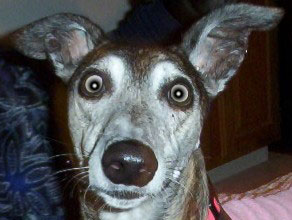Natural ways to help and prevent arthritis and spinal issues:
– Joint supplements – Glucosamine, MSM, Chondroitin, Vitamin C, CMO
– Anti-inflammatory – Yucca is one of the best
– Acupuncture – Here is a database of vets around the country
– Cold Laser
– Raw feeding with oils – Salmon and Coconut
Overview – Dr. Suzanne Stack – from 1999
As our greyhounds age, quite a few of them, especially the males, become weak, wobbly, and/or painful in the rear end. Many of these are affected by lumbosacral stenosis (LS), a narrowing of the last part of the spinal canal, which causes compression of the nerve roots.
Diagnosis
Signs are rear end pain, lameness, weakness, “shuffling,” knuckling over, foot dragging, and muscle wasting. Both urinary and fecal incontinence are possible and carry a worse prognosis. Greyhounds may even lose their appetite from the pain and “waste away.” The difficulty in diagnosing LS is twofold. Many veterinarians simply do not recognize the signs. LS looks neurologic, and technically, it is. But a rare and obscure neurological disease, it is not. Beware a diagnosis of “hip dysplasia” in a greyhound – greyhound hips are by and large excellent. The second problem is that unless your greyhound is “lucky” enough to have visible arthritis on lumbosacral x-rays, the only techniques to confirm LS are pretty high tech – CT, MRI, discography, etc.
Not only can LS be difficult to “nail down,” the other problem is that oral medications such as Rimadyl, Etogesic, aspirin, prednisone, etc. do little for LS since it is “doggy sciatica” i.e., pinching of the nerve roots.. It presents a sad problem. The “cure” is referral spinal surgery to free up the trapped nerve roots, not something many owners will consider in a geriatric greyhound. Many if not most greyhounds simply get worse and worse until euthanasia becomes necessary.
Treatment
The good news is that there is a simple palpation technique to detect LS and a way to inject Depo-Medrol intralesionally to help it, similar to what is done in humans. It was taught to me by Dr. Mike Herron, a professor of small animal orthopedic surgery at Texas A & M for 32 years, owner of racing greyhounds, and all around “greyhound guru.” You may want to clip this out for your vet to see should one of your greyhounds begin showing signs of LS. This is an easy procedure that you do with the dog standing up, basically an intramuscular injection into the lumbosacral area. There is absolutely no danger of hitting the spinal cord or any important structures. The worst thing that can happen is that it doesn’t help the dog.
******************
First, see where the L-S joint lies in relation to the iliac crests so that you hit the right spot both with your thumbs for palpating and with the needle for injecting.
Put all your fingers on the ventral ridge of the greyhound’s iliac crest. Put each thumb just medial to each iliac crest about halfway down its ridge. Your thumbs should be between the iliac crest and the vertebrae. Be sure to look at the diagram so you can see where the L-S joint lies in relation to the iliac crests. Try to “crack” (move) the L-S joint. If it hurts (or he falls to the ground!), chances are he has LS.
Draw up 20 mg of Depo-Medrol and using a 1″ needle, inject half of this into each side. Go about halfway down the ridge of the iliac crest, go in (medially) 1″, and inject just off the midline (this is where you put your thumbs to try to “crack” the L-S joint). If the greyhound does not show improvement within 48 hours, the problem is something else. Repeat as needed as Depo-Medrol’s effect wears off – usually every 3-6 months.
**************
A footnote worth mentioning for LS is Ultram, a human “combination” drug with both a narcotic-like and an anti-anxiety component. Used sometimes for bone cancer in dogs – another very painful condition – I have tried it with good results on two LS dogs when Depo-Medrol injections were not enough. A greyhound dose is 50 mg Ultram as needed for pain, given up to twice daily.
Also, support your hound with a liver/kidney supplement – milk thistle – when using any steroid or NSAID, or any drug which can have negative effects on those organs.
